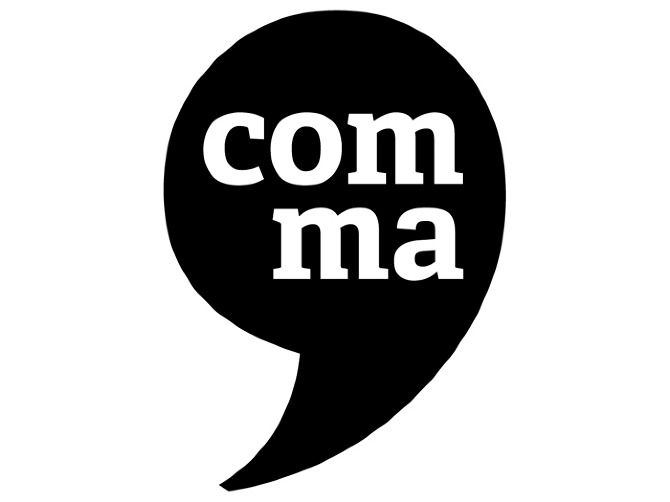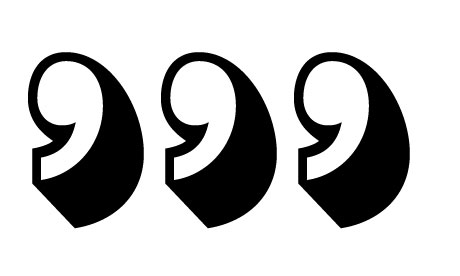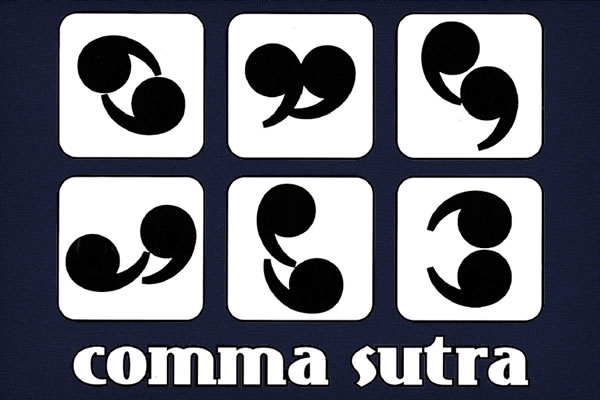
Instructional Materials for
Craig White's Literature Courses
|
Commas & "the comma rule" |
 |
"The comma appears to be a harmless little fellow, but don't let appearances deceive you. Sure, the little guy never shouts, never declares, never questions, never even finishes a sentence, for that matter, but that doesn't mean he holds no power. In fact, he is the hardest working of all the punctuation marks, the only one often appearing more than once in a single sentence. He holds the power to change the meaning of a sentence and to disrupt the flow of prose." —"Inspiration for Writers," http://users.wirefire.com/tritt/tip18.html
![]()
Overview: The comma (,) is so small, numerous, and adaptable that it inevitably involves too many rules or guidelines to remember—and even the most precise comma rules require exceptions and judgment-calls.
If the first guide to punctuation is "hear it," a comma indicates a pause, a breath, a beat or tone-shift that mediates parts of a sentence. But a comma's power is so limited that it can only separate or connect parts of a sentence or clause; it cannot mediate two independent clauses without help from a conjunction. (The last sentence is an example of a stronger punctuation like a semicolon being necessary to separate two independent clauses. If a comma had been used instead with no conjunction, the error would be called a "run-on sentence" because one sentence runs on another, or sometimes a "comma splice" from attempting to splice two sentences with a comma.)
Different writers, editors, schools, or publishers may use commas slightly differently from each other here and there for different effects, and challenging situations can cause a writer or editor to change their mind more than once. Such decision-making can be frustrating but typifies the nuance or flexibility of judgment necessary for good writing. Sometimes writing works just right as though by magic or instinct but often must be thought through carefully. Get used to that attitude with commas, and get used to being second-guessed by readers, editors, and instructors.
![]()
Overall rule: Use as few commas as possible but as many as necessary.
General effect of more or fewer commas: Since commas represent pauses or shifts, they slow down writing and give you time to consider complications. Fewer commas permit faster and more fluid forward motion. Most authors, editors, and readers prefer "fast and fluid" style, but slowdowns can help when things get complicated. If you're writing a careful explanation that requires equally careful reading, commas or their absence can guide your reader to slow down or speed up at different passages.
Rationale for using as few commas as possible but as many as are necessary: Especially since the rise of electronic media, writing must cope with shrinking attention spans by avoiding wordiness and slowing down only when necessary. More commas slow writing down. Therefore readers regard extra commas as a tax on their attention.
Potential Student Over-Reactions to Comma Problems: When an instructor marks a student's paper by adding a comma here or there, in his or her next paper a student sometimes over-reacts by using more commas than needed, thinking that way all bases are covered and no one can complain about needing a comma anywhere because commas are everywhere.
Downside to Over-Reaction: Adding an unnecessary comma may cause as much of a problem as omitting a necessary comma.
![]()
"The Comma Rule"
One rule is so central to comma-use as sometimes to be called simply, "The Comma Rule." Learning it can help you know not only when to use commas in compound or complex sentences, but also when not to use a comma.
The Comma Rule: Use a comma to separate the clauses of a compound sentence of two independent clauses connected by a coordinating conjunction (and, but, or, nor, for, so, and yet). The comma is placed before the coordinating conjunction, not after.
Examples (both correct):
-
The students ate spaghetti for dinner, but no one cleaned his plate.
-
I gave three books to John, and John gave them to Nancy
Understanding this rule and its broader application requires understanding independent clauses. Independent clauses are subject-verb or subject-predicate constructions that can stand alone as a complete sentence.
Thus in the first example, "The students ate spaghetti for dinner" and "no one cleaned his plate" are independent clauses (joined by the conjunction "but" and separated by a comma).
Other Examples (all correct):
- The game was over, but
the crowd refused to
leave.
- The student explained her question, yet the
instructor still didn't seem to understand.
- Yesterday was her brother's birthday, so she took him out to dinner.
Possible exception: The Comma Rule is fairly absolute, but the comma may sometimes be omitted if the independent clauses are very short:
Example of exception:
-
I wanted spaghetti but she wanted chow mein.
(A comma after spaghetti wouldn't be wrong, but no one would miss it.)
Counter-use of the Comma Rule: If the parts of a sentence joined by a coordinating conjunction are NOT independent clauses, a comma may not be required.
Incorrect: I turned the corner, and ran smack into a patrol car. > Correct: I turned the corner and ran smack into a patrol car.
("I turned the corner" is an independent clause, but "ran smack into a patrol car" is not because it lacks a subject.)
![]()

Commas separating elements in a series
(Serial, Oxford, or Harvard commas—or not)
A divisive question in comma usage is use of a comma or not before the conjunction and or or in a list-series of three or more. For example . . .
With serial comma: The Constitution establishes the legislative, executive, and judicial branches of government.
Without serial comma: The Constitution establishes the legislative, executive and judicial branches of government.
Who's for the serial comma: educators, grammarians, and literary circles; MLA Style Sheet, Strunk and White’s The Elements of Style, the Chicago Manual of Style.
Who's against the serial comma: most contemporary journalism incl. Associated Press (AP) Stylebook and New York Times stylebook, which says, "In general, do not use a comma before and or or in a series: The snow stalled cars, buses and trains." Most humanists (e.g., historians, philosophers, literary scholars) use the serial comma, but most social scientists (e.g., psychologists, sociologists, anthropologists) do not.
Why for or against the serial comma?
Common arguments for consistent use of the serial comma:
- Use of serial comma is consistent with conventional practice, + class status from association with "Oxford" or "Harvard."
- The extra comma's pause conforms better to the spoken cadence of such sentences.
- The serial comma can resolve or prevent ambiguity; e.g., this book dedication: “To my parents, Mother Teresa and Pope John Paul II.” (looks like MT & JP2 are your parents)
- Its use is consistent with other means of separating items in a list (for example, when semicolons are used to separate items a semicolon is consistently included before the last item even when and or or is present).
Common arguments against consistent use of the serial comma:
- The serial comma is redundant in a simple list because the and or the or may serve (by itself) to mark the logical separation between the final two items unless the final two items are not truly separate items but are two parts of a compound single item.
- Where space is at a premium the comma adds unnecessary bulk to the text.
Instructor's verdict: The serial comma is harder to write, but easier to read.
![]()
![]() Several
of many more Comma Rules
Several
of many more Comma Rules![]()
![]()
Use a comma to set off quoted elements when the introduction to the quotation is a complete subject-verb syntagm.
- Summing up this argument, Peter Coveney writes, "The purpose and
strength of the romantic image of the child had been above all to establish
a relation between childhood and adult consciousness."
- The short fellow asked, "How's the weather up there?"
Be careful not to use commas to set off quoted elements introduced by the word that or quoted elements that are embedded in a larger structure:
- Peter Coveney writes that "[t]he purpose and strength of . . ."
- We often say "Sorry" when we don't really mean it.
- She told me that I should "kick back and put my feet up."
Instead of a comma, use a colon to set off explanatory or introductory language in the form of an independent clause from a quotation that is either very formal or long (especially if it's longer than one sentence):
- The chairman was forceful in his pleas for help: "Everyone must do his or her part to make this company profitable in the third quarter."
If a complete sentence or independent clause precedes the quotation, then the colon is a better choice than a comma:
- The sign at the campsite left no room for ambiguity: "Absolutely no littering!"
![]()
Use commas to separate two or more coordinate adjectives that describe the same noun. Be sure never to add an extra comma between the final adjective and the noun itself or to use commas with non-coordinate adjectives.
Coordinate adjectives are adjectives with equal ("co"-ordinate) status in describing the noun; neither adjective is subordinate to the other. You can decide if two adjectives in a row are coordinate by asking the following questions:
- Does the sentence make sense if the adjectives are written in reverse order?
- Does the sentence make sense if the adjectives are written with and between them?
If you answer yes to these questions, then the adjectives are coordinate and should be separated by a comma. Here are some examples of coordinate and non-coordinate adjectives:
He was a difficult, stubborn child.
(coordinate)
They lived in a white frame house. (non-coordinate)
She often wore a gray wool shawl. (non-coordinate)
Your cousin has an easy, happy smile.
(coordinate)
The relentless, powerful summer sun
beat down on them. (Relentless & powerful are coordinate with each other but non-coordinate
with summer.)
The relentless, powerful,
oppressive sun beat down on them. (All three adjectives are
coordinate.)
![]()
Use commas after introductory a) dependent clauses, b) phrases, or c) words that come before the main clause.
a. Common starter words for introductory clauses that should be followed by a comma include after, although, as, because, if, since, when, while. (These "starter words" can be called "adverbial conjunctions.")
While I was eating,
the cat scratched at the door.
Because her alarm clock was broken,
she was late for class.
If you are ill,
you ought to see a doctor.
When the snow stops falling,
we'll shovel the driveway.
However, don't put a comma after the main clause when a dependent (subordinate) clause follows it (except for cases of extreme contrast).
Incorrect: The cat scratched at the door, while I was
eating. Correct: The cat scratched at the door while I was
eating.
Correct: She was still quite upset, although she had won
the Oscar. (This comma use is correct because it is an example of extreme
contrast.)
b. Common introductory phrases that should be followed by a comma include participial and infinitive phrases, absolute phrases, nonessential appositive phrases, and long prepositional phrases (over four words).
Having finished the test, he left the room.
To get a seat, you'd better come early.
After the test but before lunch, I went
jogging.
The sun radiating intense heat, we sought
shelter in the cafe.
c. Common introductory words that should be followed by a comma include yes, however, well.
Well, perhaps he meant no harm.
Yes, the package should arrive tomorrow
morning.
However, you may not be satisfied with the
results.
![]()
Use a pair of commas in the middle of a sentence to set off clauses, phrases, and words that are NOT essential to the meaning of the sentence. Use one comma before to indicate the beginning of the pause and one at the end to indicate the end of the pause.
Here are some clues to help you decide whether the sentence element is essential:
- If you leave out the clause, phrase, or word, does the sentence still make sense?
- Does the clause, phrase, or word interrupt the flow of words in the original sentence?
- If you move the element to a different position in the sentence, does the sentence still make sense?
If you answer "yes" to one or more of these questions, then the element in question is nonessential and should be set off with commas. Here are some example sentences with nonessential elements:
Clause: That Tuesday, which happens to be my birthday, is the only day when I am available to meet.
Phrase: This restaurant has an exciting atmosphere. The food, on the other hand, is rather bland.
Word: I appreciate your hard work. In this case, however, you seem to have over-exerted yourself.
Some "set-off" commas might be replaced by parentheses or dashes, with different effects:
Commas: That Tuesday, which happens to be my birthday, is the only day when I am available to meet.
Parentheses: That Tuesday (which happens to be my birthday) is the only day when I am available to meet.
Dashes: That Tuesday—which happens to be my birthday—is the only day when I am available to meet.
![]()
sources: http://grammar.ccc.commnet.edu/grammar/commas.htm, http://owl.english.purdue.edu/owl/resource/607/02/, http://www.nationalpunctuationday.com/serialcomma.html, http://en.wikipedia.org/wiki/Serial_comma, http://www.ehow.com/how_4471502_use-comma-before-quotation-marks.html, http://www.getitwriteonline.com/archive/111602colon.htm.
See also Business Insider: 13 Rules for Using Commas without Looking like an Idiot
